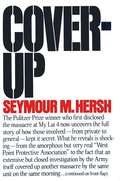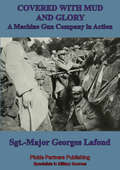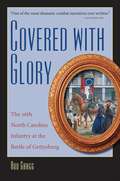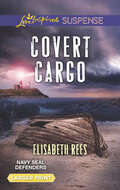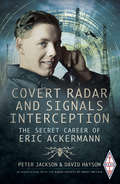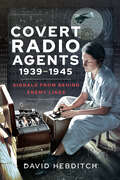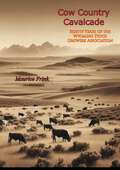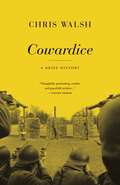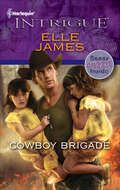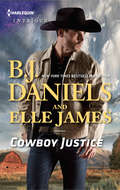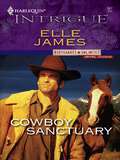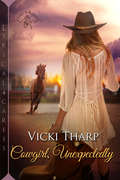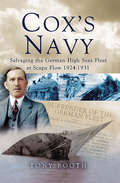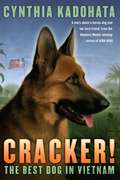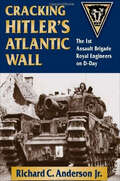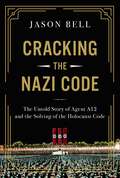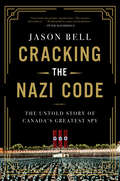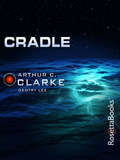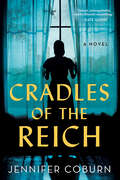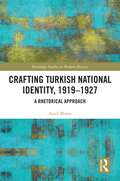- Table View
- List View
Cover-Up: The Army's Secret Investigation at My Lai 4
by Seymour M. HershThe Pulitzer Prize winner who first disclosed the massacre at My Lai 4 uncovers the full story of how those involved - from private to general - kept it secret. What he reveals is shocking - from the amorphous but very real "West Point Protective Association" to the fact that an extensive but closed investigation by the Army itself covered up another massacre by the same unit on the same morning.
Covered With Mud And Glory: A Machine Gun Company In Action ("Ma Mitrailleuse")
by Anon. Georges Lafond Edwin Gile Rich Georges ClemenceauThe author of this book, SERGEANT-MAJOR GEORGES LAFOND, of the Territorial Hussars, was in South America at the time of mobilization. He returned to France as soon as possible and joined his corps, but asked to be assigned as intelligence officer to the machine-gun sections of the first regiment of Colonial Infantry.With this picked corps, which has been decimated several times, he took part in the engagements in Champagne, on the Somme, at Lihons, Dompierre, Herbècourt, and notably in the days from the first to the fifth of July, where the regiment earned its second citation and received the fourragère.Lafond was discharged after the battles of Maisonnette, and wrote this book of recollections in the hospital at Abbeville, and afterwards at Montpellier, where he had to undergo a severe operation. Sergeant-Major Lafond's narrative makes no claim to literary pretension, but it is simply a collection of actual occurrences. It is a series of short narratives which give the life of a company of machine gunners from the day of its formation to the hour when it was so decimated that it had to be reorganized with men from other corps.
Covered with Glory
by Rod GraggThe battle of Gettysburg was the largest engagement of the Civil War, and--with more than 51,000 casualties--also the deadliest. The highest regimental casualty rate at Gettysburg, an estimated 85 percent, was incurred by the 26th North Carolina Infantry. Who were these North Carolinians? Why were they at Gettysburg? How did they come to suffer such a grievous distinction? In Covered with Glory, award-winning historian Rod Gragg reveals the extraordinary story of the 26th North Carolina in fascinating detail. Praised for its "exhaustive scholarship" and its "highly readable style," Covered with Glory chronicles the 26th's remarkable odyssey from muster near Raleigh to surrender at Appomattox. The central focus of the book, however, is the regiment's critical, tragic role at Gettysburg, where its standoff with the heralded 24th Michigan Infantry on the first day of fighting became one of the battle's most unforgettable stories. Two days later, the 26th's bloodied remnant assaulted the Federal line at Cemetery Ridge and gained additional fame for advancing "farthest to the front" in the Pickett-Pettigrew Charge.
Covert Cargo: Protecting Her Daughter Covert Cargo Last Stand Ranch (Navy SEAL Defenders)
by Elisabeth ReesIn this inspirational romantic suspense novel, an undercover Navy SEAL must protect a reclusive woman from treacherous slave traders.Undercover as a coast guard captain, Navy SEAL Dillon Randall is determined to capture the leaders of a human trafficking ring off the California coast. When a woman living in a remote lighthouse unwittingly becomes a target of the traffickers, Dillon’s mission suddenly includes protecting Beth Forrester. Yet he can’t let himself get too close to the reclusive beauty. The last time he lost focus on a mission, people died. He won’t make that mistake again. Dillon must win Beth’s trust—while keeping his identity as a SEAL a secret. However he’s finding it harder to maintain his cover around the woman working her way into his heart. Can he save Beth’s life without breaking her already wounded heart?
Covert Radar and Signals Interception: The Secret Career of Eric Ackermann
by Peter Jackson David Haysom“A remarkable reconstruction of the extensive and quite exceptional career” of a key WW2 military intelligence officer. (Royal Air Force Historical Society)Of German stock dating back to 1530 in Saxony, Eric George Ackermann GM was born on the Isle of Wight in 1919 and became a leading figure in the world of signals and electronic intelligence. As a Junior Scientific Officer at the Telecommunication Research Establishment, Boscombe Down, with an honorary commission in the Royal Air Force, he made numerous flights over occupied territory searching for, monitoring and destroying Germany’s Wuerzburg, Knickebein and X Band radar systems. Much of his research was passed to the highest levels of wartime government, ensuring that tactical plans could be executed that took full advantage of top secret German intelligence. A host of secret missions to assess the enemy’s radar capabilities were carried out in North Africa, Gibraltar and Italy. This engaging biography explores his operational deployment at the vanguard of tactical intelligence operations during WWII. Winner of the George Medal for conspicuous gallantry, Ackermann also saw conflict up close and personal. After the war, he played a major part in the implementation of a string of listening stations built along the borders of Soviet Bloc countries, which later gleaned a wealth of invaluable post-war intelligence. Further work in aeronautics and satellite construction in the United States followed. Despite Ackermann’s achievements, he has never been the subject of a book-length study until now. Covert Radar and Signals Interception will appeal to aviation enthusiasts, as well as readers curious to gain new insights into twentieth century intelligence practices and their often far-reaching consequences.
Covert Radio Agents, 1939–1945: Signals From Behind Enemy Lines
by David Hebditch“A treasure of a book…An authentic adventure saga [and] a very human story generously seasoned with ingenuity, technology and hardy individualism.” —K9YA TelegraphIncludes photos and mapsClandestine radio operators had one of the most dangerous jobs of World War II. Those in Nazi-occupied Europe for the SOE, MI6, and OSS had a life expectancy of just six weeks. In the Gilbert Islands, the Japanese decapitated seventeen New Zealand coastwatchers.These highly skilled agents’ main tasks were to maintain regular contact with their home base and pass vital intelligence back. As this meticulously researched book reveals, many operators did more than that. Norwegian Odd Starheim hijacked a ship and sailed it to the Shetlands. In the Solomon Islands Jack Read and Paul Mason warned the defenders of Guadalcanal about incoming enemy air raids, giving American fighters a chance to inflict irreversible damage on the Japanese Air Force. In 1944 Arthur Brown was central to Operation Jedburgh’s success delaying the arrival of the SS Das Reich armored division at the Normandy beachheads. The author also explains in layman’s terms the technology of 1940s radios and the ingenious codes used.Most importantly, Covert Radio Agents tells the dramatic human stories of these gallant behind-the-lines radio agents. Who were they? How were they trained? How did they survive against the odds? This is a highly informative and uplifting history of World War II’s unsung heroes.
Covert Warriors
by W.E.B. GriffinCharley Castillo and the former members of Presidential Agent's Office of Organizational Analysis are officially "retired. " But that doesn't mean they're out of action... <P><P> At a Mexican roadblock, a US Embassy SUV is stopped at gunpoint, three of its passengers murdered, and a fourth kidnapped. Everything points to the drug cartels, especially when the kidnappers say they will return the hostage if a cartel kingpin is released from US federal prison. But when word gets to Castillo and his group of retired spies and special operators, they have their doubts.<P> They believe that it's a diversion--that the murders and kidnapping were ordered by someone to lure Castillo & Company to their deaths. But even knowing that may not save them. Powerful forces in the US government are arrayed against them as well, and if one side doesn't get them. . . the other side will. .
Cow Country
by Edward Everett DaleStep into the rugged and romantic world of the American West with Edward Everett Dale's Cow Country. This evocative work paints a vivid portrait of life on the vast cattle ranges, capturing the essence of the cowboy era that defined a significant chapter of American history.Dale, a distinguished historian and storyteller, offers readers an immersive experience into the daily lives, struggles, and triumphs of cowboys and ranchers who tamed the wild landscapes of the West. With meticulous attention to detail, he chronicles the evolution of the cattle industry, from its humble beginnings to its rise as a cornerstone of the American economy.Cow Country is rich with authentic anecdotes, historical accounts, and personal reflections that bring to life the colorful characters who inhabited this world. Dale's engaging narrative delves into the routines of cattle drives, the challenges of frontier life, and the unyielding spirit of the men and women who carved out a living in a harsh and unforgiving environment.Beyond the romanticized image of the cowboy, Cow Country explores the economic and social dynamics that shaped the cattle industry. Dale provides a comprehensive look at the impact of technological advancements, market changes, and government policies on the lives of those in the cow country.This book is not just a historical account; it is a celebration of a way of life that has become an iconic part of American heritage. Whether you're a history enthusiast, a lover of Western lore, or simply intrigued by the cowboy mythos, Cow Country offers a captivating journey into the heart of the American frontier.Edward Everett Dale's Cow Country is an essential read for anyone seeking to understand the true spirit of the American West and the enduring legacy of the cowboys who helped shape it. Join Dale on this remarkable adventure and experience the grit, glory, and grandeur of the cow country.
Cow Country Cavalcade: Eighty Years of the Wyoming Stock Growers Association
by Maurice Frink"Cow Country Cavalcade" by Maurice Frink is an insightful and comprehensive chronicle of the Wyoming Stock Growers Association (WSGA), detailing its profound impact on the cattle industry and the development of the American West over eight decades. First published in 1954, this historical account delves into the founding, evolution, and achievements of one of the most significant agricultural organizations in the United States.Maurice Frink, an accomplished historian with a keen interest in Western history, provides a meticulously researched narrative that captures the spirit and challenges of the cattle industry from the late 19th century through the mid-20th century. The book begins with the establishment of the WSGA in 1872, a response to the burgeoning cattle trade and the need for a unified voice to address the concerns of stock growers in Wyoming.The narrative is enriched by a wealth of historical anecdotes and firsthand accounts that provide a deeper understanding of the daily lives of cattlemen and the operational challenges they faced. Frink explores topics such as cattle drives, roundups, rustling, range wars, and the implementation of grazing regulations, offering a comprehensive look at the complexities of cattle ranching. He covers the significant events, influential personalities, and key decisions that guided the WSGA through periods of growth, economic downturns, and social change."Cow Country Cavalcade: Eighty Years of the Wyoming Stock Growers Association" is an essential read for anyone interested in the history of the American West, the cattle industry, or agricultural organizations. Maurice Frink's thorough research and engaging writing style make this book a captivating and informative tribute to the resilience and innovation of Wyoming's cattlemen and the enduring legacy of the WSGA.
Cowardice: A Brief History
by Chris WalshA provocative look at how cowardice has been understood from ancient times to the presentCoward. It's a grave insult, likely to provoke anger, shame, even violence. But what exactly is cowardice? When terrorists are called cowards, does it mean the same as when the term is applied to soldiers? And what, if anything, does cowardice have to do with the rest of us? Bringing together sources from court-martial cases to literary and film classics such as Dante's Inferno, The Red Badge of Courage, and The Thin Red Line, Cowardice recounts the great harm that both cowards and the fear of seeming cowardly have done, and traces the idea of cowardice’s power to its evolutionary roots. But Chris Walsh also shows that this power has faded, most dramatically on the battlefield. Misconduct that earlier might have been punished as cowardice has more recently often been treated medically, as an adverse reaction to trauma, and Walsh explores a parallel therapeutic shift that reaches beyond war, into the realms of politics, crime, philosophy, religion, and love.Yet, as Walsh indicates, the therapeutic has not altogether triumphed—contempt for cowardice endures, and he argues that such contempt can be a good thing. Courage attracts much more of our attention, but rigorously understanding cowardice may be more morally useful, for it requires us to think critically about our duties and our fears, and it helps us to act ethically when fear and duty conflict.Richly illustrated and filled with fascinating stories and insights, Cowardice is the first sustained analysis of a neglected but profound and pervasive feature of human experience.
Cowboy Brigade (Daddy Corps #3)
by Elle JamesA special agent is back in Texas to investigate a crime heartbreakingly close to home in the New York Times–bestselling author’s romantic suspense series.Agent Wade Coltrane, ex-Army Special Forces, has returned home to Freedom, Texas, for his next assignment: infiltrate the Long K Ranch and bust the owner for attempted murder. The obstacle: Lindsay Kemp, his high school sweetheart—and his target’s granddaughter. Wade didn’t expect Lindsay to still be living on the ranch—or to be a single mother every bit as beautiful and spirited as he remembered. Each day he spends undercover only intensifies his lingering desire for Lindsay and rouses his protective instincts. And he’ll need them, for there’s a killer on the ranch, and he’s set his vengeful sights on Lindsay. . . .
Cowboy Justice: Second Chance Cowboy\Navy SEAL Justice
by B. J. Daniels Elle JamesNew York Times bestselling authors B.J. Daniels and Elle James present heart-stopping suspense where everything rides on the shoulders of two of rugged cowboys. One Tall, Dark Montana Mystery The gorgeous hunk of cowboy flesh had a name—Hank Monroe—and just about every woman in Whitehorse dreamed of being his match. So why would the newcomer want to date plain old Arlene Evans? When Arlene's pregnant daughter disappears, Hank's got the connections to close the case. But she's discovering that Hank's got secrets of his own. Their lives are on the line, but nothing in this rough and tumble world can tear Hank and Arlene apart. Originally published in May 2008 as Second Chance Cowboy. A SEAL Undercover FBI agent Melissa Bradley is used to cryptic assignments like this: retrieve package from PO Box and deliver to old friend. Package in hand, she's attacked by thugs—and she's not about to trust the handsome and dangerous rescuer who claims he was sent to protect her. A former Navy SEAL turned cowboy and suddenly reinstated, there's clearly more to James Monahan's covert op than he'll admit. And as a dangerous band of traitors, terrorists and killers close in, survival means trusting each other—their toughest mission yet. Originally published in May 2015 as Navy SEAL Justice.
Cowboy Sanctuary (Bodyguards Unlimited: Denver, CO #3)
by Elle JamesAn Army vet turned security expert must protect his former flame from a dangerous threat in this romantic suspense tale by a New York Times bestseller.A JOB HE COULDN’T REFUSETen years ago, Army Ranger Cameron Morgan left his family’s ranch with no plans to return . . . until his job as a bodyguard reunited him with his former sweetheart and the life he’d fled.A PAST HE COULDN’T FORGETJennie Ward had been injured and her ranch sabotaged, so Cameron was critical to surviving an investigation that was getting riskier by the minute. But keeping his professional distance was nearly impossible, especially after Jennie nearly lost her life on his watch.Still, as his need to guard her mixed with his hunger to find the truth, Cameron found it hard to resist the pull of his old life—not to mention Jennie’s offer of a second chance . . .
Cowgirl, Unexpectedly (Lazy S Ranch #1)
by Vicki TharpA Harley and a highway are all an Iraqi war veteran needs to soothe her restless spirit—until a pit stop puts her on the front lines of love . . . Settling down is not an option for Mackenzie Parish. Since the end of her tour of duty, the former Marine has been on the road, doing what she can to ease the pain of her wounded shoulder and mind. But when her money runs out, she takes a job on a Wyoming ranch—and finds herself in unfamiliar territory once more . . . Mackenzie’s lesson number one: a horse is definitely nothing like a motorcycle. But even knee deep in manure, and saddle sores aside, Mac finds comfort in the daily routine of hard work and the great outdoors. Only her bunkmate, Hank Nash, provides an unsettling distraction. The former champion bull rider has returned home to reconnect with his estranged daughter. Yet despite his own struggles, he has the patience to show Mac the ropes, and the sweet touch to draw her out of herself—and her painful past. But when the ranch becomes the target of violent threats, Mac will have to choose between the call of the road—and the man who has helped her feel whole again . . .
Cox's Navy: Salvaging the German High Seas Fleet at Scapa Flow, 1924–1931
by Tony BoothA deep dive into the biggest salvage operation in history: the recovery of German warships—the Allies&’ spoils of World War I—from Scottish waters. On Midsummer&’s Day 1919 the interned German Grand Fleet was scuttled by their crews at Scapa Flow in the Orkney Islands despite a Royal Navy guard force. Greatly embarrassed, the Admiralty nevertheless confidently stated that none of the ships would ever be recovered. Had it not been for the drive and ingenuity of one man there is indeed every possibility that they would still be resting on the sea bottom today.Cox&’s Navy tells the incredible true story of Ernest Cox, a Wolverhampton-born scrap merchant, who despite having no previous experience, led the biggest salvage operation in history to recover the ships. The 28,000-ton Hindenberg was the largest ship ever salvaged. Not knowing the boundaries enabled Cox to apply solid common sense and brilliant improvisation, changing forever marine salvage practice during peace and war.
Cracker!: The Best Dog in Vietnam
by Cynthia KadohataCRACKER IS ONE OF THE UNITED STATES ARMY'S MOST VALUABLE WEAPONS: a German shepherd trained to sniff out bombs, traps, and the enemy. The fate of entire platoons rests on her keen sense of smell. She's a Big Deal, and she likes it that way. Sometimes Cracker remembers when she was younger, and her previous owner would feed her hot dogs and let her sleep in his bed. That was nice, too. Rick Hanski is headed to Vietnam. There, he's going to whip the world and prove to his family and his sergeant -- and everyone else who didn't think he was cut out for war -- wrong. But sometimes Rick can't help but wonder that maybe everyone else is right. Maybe he should have just stayed at home and worked in his dad's hardware store. When Cracker is paired with Rick, she isn't so sure about this new owner. He's going to have to prove himself to her before she's going to prove herself to him. They need to be friends before they can be a team, and they have to be a team if they want to get home alive. Told in part through the uncanny point of view of a German shepherd, Cracker! is an action-packed glimpse into the Vietnam War as seen through the eyes of a dog and her handler. It's an utterly unique powerhouse of a book by the Newbery Medal-winning author of Kira-Kira.
Cracking Hitler's Atlantic Wall: The 1st Assault Brigade Royal Engineers on D-Day
by Richard C AndersonA military historian analyzes the ingenious WWII tanks known as Hobart&’s Funnies, detailing their development and their role in the D-Day campaign. When the British and Canadians landed in Normandy on June 6, 1944, they were accompanied by specialized armored vehicles designed to remove German obstacles and mines. Developed by the Royal Engineers, these tanks known as Hobart's Funnies featured a range of ingenious innovations, from carpet-laying and bridge-laying devices to a giant 290-millimeter mortar. Examining these vehicles from technical development to combat deployment, military historian Richard C. Anderson Jr. gives a minute-by-minute account of D-Day's early hours on Sword, Juno, and Gold Beaches—the critical moments when success hinged on the assault engineers&’ ability to clear a path or breach the seawall. Anderson also describes the events on Omaha and Utah Beaches, where U.S. troops, despite being offered these vehicles, stormed ashore without them. Through careful comparison of conditions and outcomes, Anderson assesses the vehicles&’ performance and impact on D-Day's successes and failures.
Cracking the Code: The Riddle of the Enigma Machine (Fountas & Pinnell Classroom, Guided Reading)
by Louise HegazziNIMAC-sourced textbook. INTRIGUE and ESPIONAGE. Desperate times often call for desperate measures, and from where the Allied forces sat, World War II was no exception. The Nazis were on a mission to take over Europe, and the Allies were just as determined to preserve their freedom and defeat the enemy. The Allies’ strategy: to crack the Nazis’ codes, anticipate their next moves, and beat them at their own game. Enter the Enigma Machine.
Cracking the Luftwaffe Codes: The Secrets of Bletchley Park
by Gwen WatkinsAn intriguing page-turning and personal account of that most secretive of wartime institutions, Bletchley Park, and of the often eccentric people who helped to win the war Beryl BainbridgeBletchley Park, or 'Station X', was home to the most famous code breakers of the Second World War. The 19th-century mansion was the key center for cracking German, Italian and Japanese codes, providing the allies with vital information. After the war, many intercepts, traffic-slips and paperwork were burned (allegedly at Churchill's behest). The truth about Bletchley was not revealed until F. Winterbotham's The Ultra Secret was published in 1974. However, nothing until now has been written on the German Air Section. In Cracking the Luftwaffe Codes, former WAAF (Women's Auxiliary Air Force) Gwen Watkins brings to life the reality of this crucial division. In a highly informative, lyrical account, she details her eventful interview, eventual appointment at the 'the biggest lunatic asylum in Britain', methods for cracking codes, the day-to-day routine and decommissioning of her section.
Cracking the Nazi Code: The Untold Story of Agent A12 and the Solving of the Holocaust Code
by Jason BellThe thrilling true story of Agent A12, the earliest enemy of the Nazis, and the first spy to crack Hitler&’s deadliest secret code: the framework of the Final Solution.In public life, Dr. Winthrop Bell was a Harvard philosophy professor and wealthy businessman. As an MI6 spy—known as secret agent A12—in Berlin in 1919, he evaded gunfire and shook off pursuers to break open the emerging Nazi conspiracy. His reports, the first warning of the Nazi plot for World War II, went directly to the man known as C, the mysterious founder of MI6, as well as to various prime ministers. But a powerful fascist politician quietly worked to suppress his alerts. Nevertheless, Dr. Bell's intelligence sabotaged the Nazis, in ways only now revealed in Cracking the Nazi Code. As World War II approached, Bell became a spy once again. In 1939, he was the first to crack Hitler&’s deadliest secret code: Germany&’s plan for the Holocaust. At that time, the führer was a popular politician who said he wanted peace. Could anyone believe Bell&’s shocking warning? Fighting an epic intelligence war from Eastern Europe and Russia to France, Canada, and finally Washington, DC, agent A12 was a real-life 007, waging a single-handed struggle against fascists bent on destroying the Western world. Without Bell&’s astounding courage, the Nazis just might have won the war.
Cracking the Nazi Code: The Untold Story of Canada's Greatest Spy
by Jason BellThe thrilling true story of agent A12, the earliest enemy of the Nazis“Brilliantly researched. . . . A page-turner, one of those books not to be missed.” —Rosemary Sullivan, author of Stalin’s Daughter“Who knew that a Canadian was the first to warn the world what the Nazis were up to, and to do it years before anyone else was even talking about Nazis? Winthrop Bell is a name you should know, and thanks to Jason Bell and his deep-dive research, you now will.” —Peter MansbridgeIn public life, Dr. Winthrop Bell of Halifax was a Harvard philosophy professor and wealthy businessman. But as MI6 secret agent A12, he evaded gunfire and shook off pursuers to break open the emerging Nazi conspiracy in 1919 Berlin. His reports, the first warning of the Nazi plot for WWII, went directly to the man known as C, the mysterious founder of MI6. Throughout this, a powerful fascist politician quietly worked to suppress Bell’s alerts. Nevertheless, agent A12’s intelligence sabotaged the Nazis in ways that are only now being revealed. Bell became a spy once again in the face of WWII. In 1939, he was the first to crack Hitler’s deadliest secret code: the Holocaust. But the führer was a popular politician who said he wanted peace. Could anyone believe Bell’s shocking warning? Fighting an epic intelligence war from Ukraine, Russia and Poland to France, Germany, Canada and Washington, DC, A12 was the real-life 007, waging a single-handed fight against madmen bent on destroying the world. Without Bell’s astounding courage, the Nazis might just have won the war. Informed by recently declassified documents, Cracking the Nazi Code is the first book to illuminate the astonishing exploits of Winthrop Bell, agent A12.
Cradle (Arthur C. Clarke Collection)
by Arthur C. Clarke Gentry LeeA journalist hunting military secrets uncovers an alien presence off the Florida Keys in this novel by the award-winning author of 2001: A Space Odyssey. In 1994, an experimental navy missile mysteriously disappears off the coast of Florida during testing. While investigating the link between the disappearance and some unusual whale sightings, journalist Carol Dawson finds much more: a strange golden trident that may be worth millions . . . and may not be of earthly origin. While Dawson and treasure hunter Nick Williams try to make sense of their discovery, they must also outwit thieves and criminals to keep it safe. But the trident leads them to another, more unsettling discovery. Deep underwater, Dawson and Williams encounter the highly advanced beings that placed the trident where it is. And their plans for it could change the face of humanity forever. In Cradle, the Hugo and Nebula Award–winning author Arthur C. Clarke, widely considered one of the most important figures in science fiction literature, teams up with author Gentry Lee to deliver another thrilling tale of alien contact and human conflict.
Cradle of the Texas Republic
by Joy Montgomery Dr Robin MontgomeryThe Cradle of Texas Road encircles the Lone Star landscapes that nurtured so much of the state's early history, from European settlement through the Texas Republic. The first attempt at Texan liberation ended in the bloodiest battle in Texas history, after the insurgents divided their forces along racial lines at Medina in 1813. It required Sam Houston's more collaborative approach at the Battle of San Jacinto in 1836 to finally realize the dream of Texas independence. Local historians Robin and Joy Montgomery transcribe the region bounded by Navasota, Madisonville, Hunstsville and Conroe into a master class on the subject of nation-building and cultural integration.
Cradles of the Reich: A Novel
by Jennifer Coburn"Every historical fiction novel should strive to be this compelling, well-researched and just flat-out good." — Associated PressFor fans of The Nightingale and The Handmaid's Tale, Cradles of the Reich uncovers a topic rarely explored in fiction: the Lebensborn project, a Nazi breeding program to create a so-called master race. Through thorough research and with deep empathy, this chilling historical novel goes inside one of the Lebensborn Society maternity homes that existed in several countries during World War II, where thousands of "racially fit" babies were bred and taken from their mothers to be raised as part of the new Germany.At the Heim Hochland maternity home in Bavaria, three women's lives coverage as they find themselves there under very different circumstances. Gundi is a pregnant university student from Berlin. An Aryan beauty, she's secretly a member of a resistance group. Hilde, only eighteen, is a true believer in the cause and is thrilled to carry a Nazi official's child. And Irma, a 44-year-old nurse, is desperate to build a new life for herself after personal devastation. Despite their opposing beliefs, all three have everything to lose as they begin to realize they are trapped within Hitler's terrifying scheme to build a Nazi-Aryan nation. A cautionary tale for modern times told in stunning detail, Cradles of the Reich uncovers a little-known Nazi atrocity but also carries an uplifting reminder of the power of women to set aside differences and work together in solidarity in the face of oppression."Skillfully researched and told with great care and insight, here is a World War II story whose lessons should not—must not—be forgotten." — Susan Meissner, bestselling author of The Nature of Fragile Things
Crafting Turkish National Identity, 1919-1927: A Rhetorical Approach (Routledge Studies in Modern History)
by Aysel MorinExamining Mustafa Kemal Atatürk’s Büyük Nutuk (The Great Public Address), this book identifies the five founding political myths of Turkey: the First Duty, the Internal Enemy, the Encirclement, the Ancestor, and Modernity. Offering a comprehensive rhetorical analysis of Nutuk in its entirety, the book reveals how Atatürk crafted these myths, traces their discursive roots back to the Orkhon Inscriptions, epic tales, and ancient stories of Turkish culture, and critiques their long-term effects on Turkish political culture. In so doing, it advances the argument that these myths have become permanent fixtures of Turkish political discourse since the establishment of Turkey and have been used by both supporters and detractors of Atatürk. Providing examples of how past and present leaders, including Recep Tayyip Erdoğan, a vocal critic of Atatürk, have deployed these myths in their discourses, the book offers an entirely new way to read and understand Turkish political culture and contributes to the heated debate on Kemalism by responding to the need to go back to the original sources – his own speeches and statements – to understand him. Contributing to emerging discourse-based approaches, this book is ideal for scholars and students of Turkish Studies, History, Nationalism Studies, Political Science, Rhetorical Studies, and International Studies.
